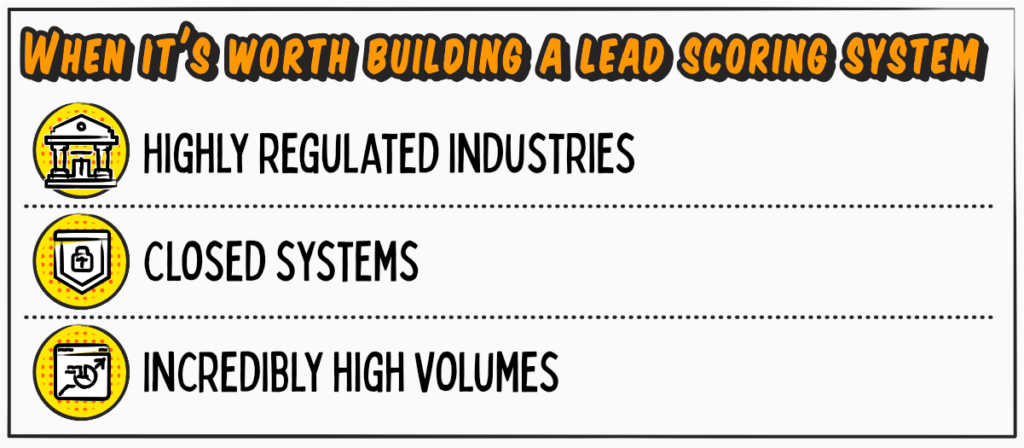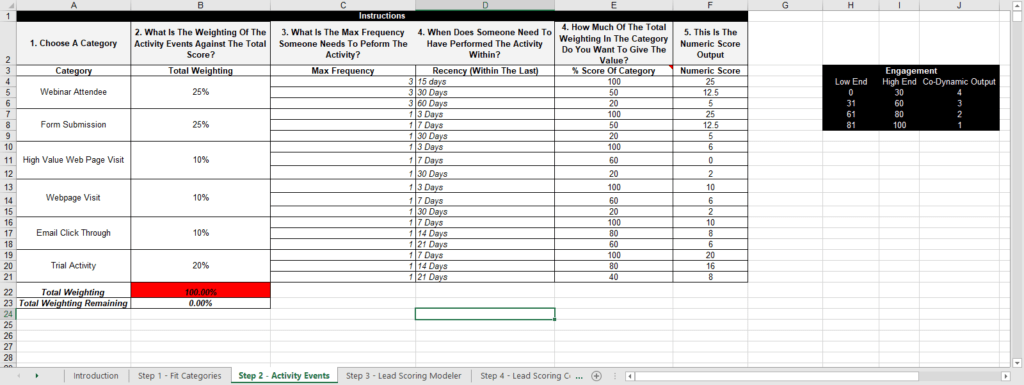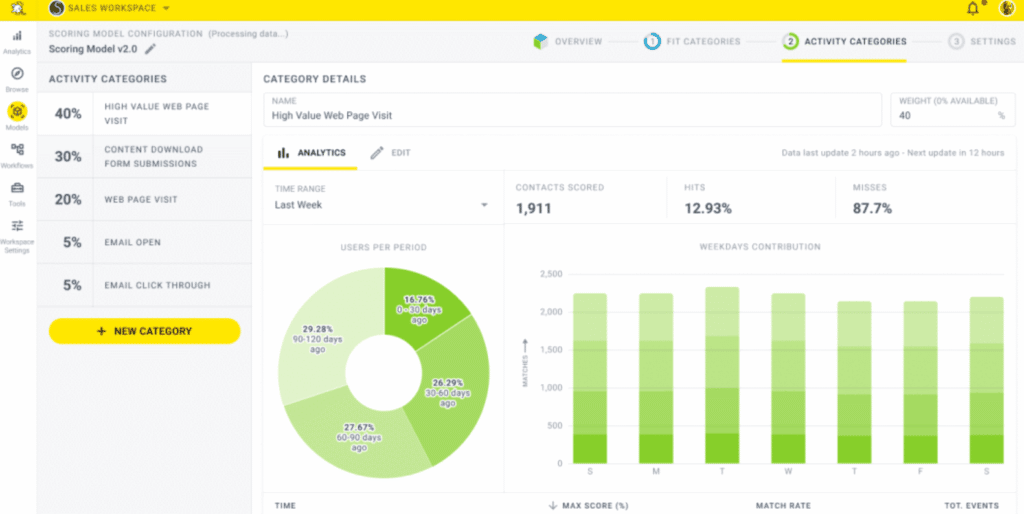Build vs. Buy, that’s the problem.
During my career, I’ve seen this dilemma pop up on a weekly basis on nearly all fronts.
Should we build a notification system for our app or use a third-party tool? Do we code our own landing pages or use one of the many tools out there?
It never stops. From product development to marketing and sales, any organization with an internal development team will sooner or later have to figure out if they should build their own system to address a problem or buy it from a third party.
Lead scoring is no exception. I’ve joined endless battles between the development, marketing, and sales teams on how to implement a lead scoring system.
Many of these battles resulted in hundreds of thousands of dollars spent on huge internal projects that often resulted in a sub-par solution compared to what the market offered at way lower prices.
The reality is there’s no one-size-fits-all answer, and my goal here is to give you all the information to make the best decision for your business.
Let’s start analyzing the pros and cons of buying vs. building your lead scoring system.
My personal “Buy vs. Build” rule of thumb
In my career, I’ve been on all sides of a table; I’m a jack of all trades. I’m a developer and a marketer; I’ve run a development agency and multiple startups building and selling their own products. I’ve bought, built, and sold software.
I always have an internal struggle. The developer in me gets easily excited about building new interesting stuff. The marketer in me doesn’t care about the technology; he just wants to see the business outcome (pipeline and revenue) as fast as possible.

Over the years, I’ve built a framework to decide when to build and when to buy based on the following criteria:
- Simplicity
- Speed
- Competitive Advantage
- Costs
Let’s go through each item more in-depth.
Simplicity
I’m a strong believer that simplicity always wins in the long run. The more I can keep everything simple, the happier I am.
When I was running my first business, a development agency, for over ten years, we decided to build a lot of internal tools instead of buying existing solutions.
While everything worked out well on a project-by-project basis, they added up and resulted in a nightmare:
- There were many different internal tools we had built and had to maintain to the point where the maintenance of internal tools was consuming 20% of our capacity.
- Some of them were interconnected. Updating one required updating all the others.
- Onboarding new developers was a nightmare because of all the “small and simple tools” they had to learn to work on and maintain.
- As we added more and more pieces, the system became more and more unreliable.
- When key resources left the company, older tools often had no one with first-hand experience updating them.
A lot of these simple tools we had built were somehow better or more custom than what was available on the market back then.
The problem is they were not our core business, and we had a limited number of resources to allocate to them. As we added more and more things, all the available resources were allocated to maintenance, and we had no capacity for improvements.
Quickly the market caught up, and the third-party tools we didn’t want to buy became way better and more useful than our own versions.
Whenever possible, try to go the simplest way, no matter how good or efficient you are. As Peter Drucker wrote in 1963 in his article “Managing for business effectiveness“:
There is surely nothing quite so useless as doing with great efficiency what should not be done at all.
Speed
I’ll use Facebook’s mantra here: “Done is better than perfect.”
If there’s no clear winner based on costs and complexity, I’d rather have something my business needs today rather than in a month, so I’ll always go for the solution I can get up and running faster.
Don’t get me wrong; this is not always a clear win for third-party solutions. For complex products, sometimes building could be faster than buying.
Always get a clear understanding of how long is the sales cycle for the product you’re looking to buy and if it requires a complex setup, get all the stakeholders aligned on how long it will take to go live.
Competitive Advantage
Competitive Advantage is a pillar of my decisional framework.
I want my team to focus on building things that create a competitive advantage.
Building an internal system to send newsletters doesn’t provide me any competitive advantage over my competitors using Hubspot… so I’ll just buy Hubspot.
Even when I’m building a product, I always think about what parts of the product create a competitive advantage and which parts I could offload to another saas tool. Notifications are great examples. Every software needs a notification system, but it’s hardly a competitive advantage. So why build it and maintain it rather than using something like MagicBell like we’re doing in Breadcrumbs?
A lead scoring system is hardly a competitive advantage. Your lead scoring model used to score your leads is, of course, unique to you and can be a big advantage. But why build the overall system to retrieve leads, score them and route them when you can rely on something like Breadcrumbs and focus only on customizing your model?
Build vs. Buy Cost

This is the hardest part to estimate. Developers always tend to underestimate how much time a task will take. Let alone its maintenance.
On the build side, you have more certainty about your costs. But still, you’ll need to figure out implementation costs.
It’s easy to predict how much you’ll pay for Hubspot. It’s harder to estimate the work required to fully deploy it within your website and application. There’s customization, data integration, template design, and so on to take into account.
On the build side, things are even more complex. You’ll need to write full specs of what’s required and then get an estimation of timing and costs from your team. I tend to be conservative and add between 50% and 100% to the estimation I receive. After all… have you ever seen a development project delivered on time? 🙂
OneSignal has come up with a great formula to understand the real cost of building something internally. Here it is:
Cost to Build = Initial Build Time (months) + Hosting Costs for Various Device Types + Cost to Maintain + Cost of Updating for Every Software Update + Cost of Adding Features + Building and Maintaining Security + Opportunity Cost.
Once I have an estimation of the costs, I usually allocate from 5 to 10% of that cost monthly for maintenance. There’s no magic number here. Maintenance is usually more time-consuming in the first 3-6 months as bugs as discovered, then things tend to stabilize.
The maintenance cost is also very tied to how much what you’re building integrates with other systems. API changes all the time, and you’ll have to adapt your implementation. For instance, integrating REST APIs with databases like MySQL can be challenging; for methods on how to simplify this process, check out this guide on REST API to MySQL.
As an example, Facebook has breaking changes to its ads APIs at least twice per year.
When dealing with lead scoring, keep in mind that while your lead scoring system will only require tweaks to improve it over time, you’ll have to deal with many integrations: CRM, Analytics, Marketing Automation, and so on.
All these API integrations will require continuous updates and secure API management maintenance unless you have a single data warehouse where all your leads’ data are already stored. Implementing a Lip Sync API could also streamline and enhance the integration process by providing more efficient synchronization and data handling capabilities.
Finally, you’ll need to estimate operational costs and opportunity costs.
You’ll need servers, databases, and so on to keep the tool running. Nowadays, these costs can be quite cheap, but they scale fast. When it comes to lead scoring, you could easily end up paying hundreds if not thousands of dollars per month on the database, which is gonna be your most expensive element.
And let’s close this roundup on costs with opportunity costs.
Opportunity costs represent the potential benefits a business misses out on when choosing one alternative over another.
Whatever you are building, the big question is: What else could I build instead with these resources?
You should know my point of view by now. I prefer to invest resources in things that create a competitive advantage. I strongly advise you to buy all the things that are undifferentiating.
When it’s worth building a lead scoring system
As you might have guessed, I’m not a huge fan of building your own lead scoring system. I’ve seen too many companies spend hundreds of thousands of dollars and months of effort building a lead scoring system that matched every ask from the sales team… and in the end, was sub-par and way more expensive than what the market was already offering.
Remember, your competitive advantage is the scoring model you’ll build with your marketing and sales team that creates a competitive advantage, not the underlying technology to sync, score and route leads.
Still, there are some use cases where it’s a wise choice to build your lead scoring system internally.

Highly regulated industries
If you are in a highly regulated industry like healthcare or, sometimes, finance/fintech, you might be subject to heavy restrictions on how you use your leads’ data to the point that sometimes sharing them with a third party might be totally impossible.
In most industries, finding a partner with certifications like SOC 2 is good enough and fully compliant with international regulations.
Here I’m talking about heavily regulated industries, not the common GDPR privacy regulation. Under GDPR is totally ok to use third-party tools that are GDPR compliant. In this case, actually buying a SaaS tool would be much easier to avoid the extra cost of building all the GDPR-related features by yourself.
Closed Systems
It’s rare, but some businesses don’t rely on any standard solution for marketing and sales, and they have completely private, custom-built infrastructures.
Integrating with all your company data sources is one of the heaviest things to build. Google Analytics, Hubspot, Salesforce, Mixpanel, Zendesk… building and maintaining all those API integrations comes at a steep price.
Buying the right lead scoring system can get you up and running in a matter of days rather than months usually.
However, if all your data are stored in internal systems, and you’re not using any major Martech player, it might be faster to stay consistent and build your scoring model within the company where you can plug it directly into your data sources.
This is usually a very uncommon scenario. Most companies have their data spread across multiple platforms, both public and private. In this scenario, you have to evaluate the pros and cons. Still, it’s usually faster to buy a lead scoring system that can plug in all your public systems and accept data from your private infrastructure through APIs or webhooks.
Incredibly high volumes
If your company handles hundreds of thousands of leads per month or even millions of leads per month, calculating the real cost of build vs. buy becomes extremely important.
Most lead scoring tools are priced based on usage, and that can add up quickly if you have extremely high volumes.
Most tools will offer you great discounts in this use case, but still, it could end up being expensive.
Prices will also increase exponentially on the build side, tho’. The development will be more complex to be reliable at those volumes. Infrastructure will need to be adequately scaled, and security and maintenance will eat up more resources.
There’s no clear winner here; you’ll just need to spend more time and energy estimating the long-term costs of both options.
When should you buy a Lead Scoring System?
I might be biased, but honestly, I think buying a lead scoring system is the best way to go for most businesses.
Lead scoring is a critical component of the sales and marketing team’s collaboration and, when done right, can quickly unlock revenue acceleration.
When your business gets to the point where you understand you need a lead scoring system to improve your sales team efficiency, it’s usually too late, and you’re already leaving money on the table. Your sales team needs leads coming from marketing scored as soon as possible!
Buying a lead scoring tool will guarantee you a faster turnaround; with Breadcrumbs, you can usually get your scoring model up and running within a day. On the other side, if you had to build it from scratch, you’d likely be looking at 2 to 6 months of development, hoping everything goes according to plans.
The reality is, no matter what your business is, lead scoring is critical for your success. But it’s not your core business.
What’s gonna create a unique advantage over your competitors? Not the software you build. It’s the lead scoring model your marketing and sales team will fine-tune on top of the software.
That’s where all your energies should be focused. Iterating multiple scoring models and variables until you find the right formula to make sure your sales team only spends time on leads with a high likelihood of becoming customers.
By the way, while you make up your mind on the buy vs. build dilemma, your teams can already start working on how to score leads using our free lead scoring template.

Bonus tips on how to pick the best lead scoring tool for you
I hope I’ve managed to give you a good overview of the hidden costs of building a lead scoring system internally and I’ve set you on the right path to make the best decision for your business.
If you’ve decided to buy an external tool to implement your lead scoring model, here are some key elements you should be looking out for:
Machine-assisted, not machine-driven
Machine learning and AI are changing the world.
Yet, you want your marketing and sales team to be in the driver’s seat for the foreseeable future. I recommend you pick a vendor that uses ML and AI to help you build your model and to give you recommendations on how to improve it.
You don’t want a black box that unpredictably crunches data and outputs a score your sales team cannot understand and trust.
It plays nicely with your MarTech stack
One of the biggest advantages of using a SaaS tool to score your leads is not having to build and maintain API connections with all your marketing tools.
Be sure that the tool you pick has a large integrations catalog and will play nicely with your current and future stack.
Education
I keep repeating this over and over. Magic wands don’t exist.
Any tool you use, no matter how amazing it is, will not magically solve all your problems. It’s always gonna be as good as the user who’s using it.
That’s why I like to pick companies that also invest in their users’ education. Whether it’s blog posts, video courses, webinars, or 1-to-1 training, be sure they’re not selling you just software but also a path to grow your marketing and sales team into lead scoring experts.
-
Lead Scoring vs Lead Nurturing: 7 Differences to Maximize Your Sales Funnel
Read more: Lead Scoring vs Lead Nurturing: 7 Differences to Maximize Your Sales FunnelManaging leads effectively means prospects move through the funnel efficiently, resulting in more conversions and…
Get a glimpse of what lead scoring could do for your business in the next 10 minutes
No matter what you’ll choose, you can start playing with lead scoring right away.
Just create a free Breadcrumbs account, connect your CRM of choice and start playing with your scoring model.

If it’s not a good fit for you, no offense taken, I guarantee.
Even if you want to go the build route, playing with Breadcrumbs will give you a lot of inspiration and understanding of the key components you should plan to internally build a lead scoring system to rank your leads!



